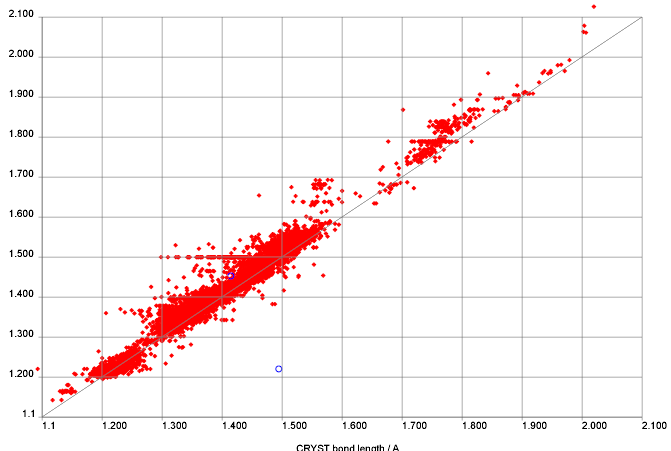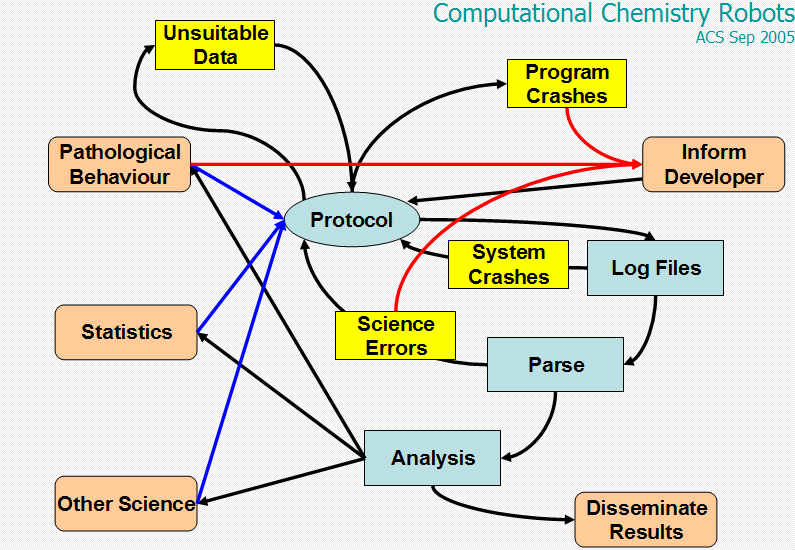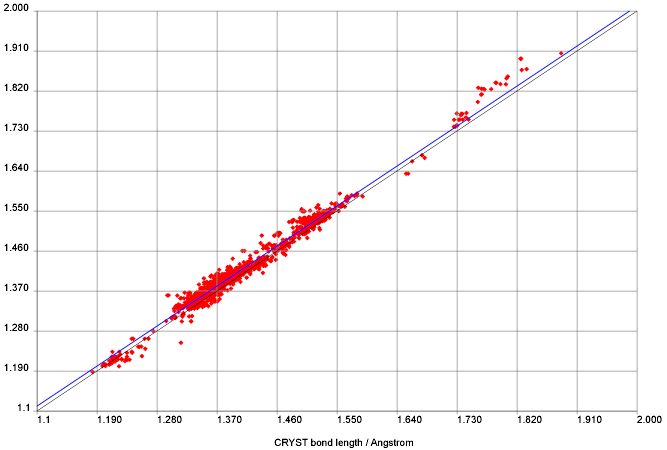Joe Townsend has worked with our group for ca. 6 years. As an undergraduate he worked as a summer student and was one of the first co-authors of OSCAR. He’s submitted his thesis and is being examined on Wednesday. His work has greatly informed what Nick Day has been doing. Here’s a snippet of what he has in his thesis (we are currently writing the paper)
He extracted small molecular entities from the data – what is now CrystalEye – WWMM – and optimsed the geometry in much the same was a Nick has been doing. He then compared the calculated and observed geometries of over 1000 entries and got:

This shows a wide scatter (y is calc, x is observed). Is the deviation due to problems with the data or problems with the model or both? Have a think and then read on…
By carefully analysing outliers Joe came up with about 10 ways that the data might have problems. Because the data were Open, and because the metadata were Open and rich, Joe was able to create a protocol that filtered out entries with potential problems in the data. The protocol was NOT based on the fact of an entry being an outlier, but with some aspect of metadata. (Here is PART of the protocol)

As a result it was possible to devise a machine procedure which AUTOMATICALLY created a cleaned data set. The resulting comparison then looked like this:

You can see immediately that although there are many fewer entries the agreement is excellent. As a result, and only as a result, it was possible to find outliers where there were potential concerns about the quality of the calculated data. The effects are small, but probably real. We’ll see if the examiners agree. (The obvious outlier above (1.31, 1.25) is due to differences in the models – gas-phase versus crystal – i.e. “crystal packing forces”)
This shows that in principle it is possible to create robots which use both theory and experiment to improve each other. It relies on having good open metadata and open data.
It is impossible with closed data. The next post will contrast Nick’s results for NMR.
-
Recent Posts
-
Recent Comments
- pm286 on ContentMine at IFLA2017: The future of Libraries and Scholarly Communications
- Hiperterminal on ContentMine at IFLA2017: The future of Libraries and Scholarly Communications
- Next steps for Text & Data Mining | Unlocking Research on Text and Data Mining: Overview
- Publishers prioritize “self-plagiarism” detection over allowing new discoveries | Alex Holcombe's blog on Text and Data Mining: Overview
- Kytriya on Let’s get rid of CC-NC and CC-ND NOW! It really matters
-
Archives
- June 2018
- April 2018
- September 2017
- August 2017
- July 2017
- November 2016
- July 2016
- May 2016
- April 2016
- December 2015
- November 2015
- September 2015
- May 2015
- April 2015
- January 2015
- December 2014
- November 2014
- September 2014
- August 2014
- July 2014
- June 2014
- May 2014
- April 2014
- March 2014
- February 2014
- January 2014
- December 2013
- November 2013
- October 2013
- September 2013
- August 2013
- July 2013
- May 2013
- April 2013
- March 2013
- February 2013
- January 2013
- December 2012
- November 2012
- October 2012
- September 2012
- August 2012
- July 2012
- June 2012
- May 2012
- April 2012
- March 2012
- February 2012
- January 2012
- December 2011
- November 2011
- October 2011
- September 2011
- August 2011
- July 2011
- May 2011
- April 2011
- March 2011
- February 2011
- January 2011
- December 2010
- November 2010
- October 2010
- September 2010
- August 2010
- July 2010
- June 2010
- May 2010
- April 2010
- August 2009
- July 2009
- June 2009
- May 2009
- April 2009
- March 2009
- August 2008
- July 2008
- June 2008
- May 2008
- April 2008
- March 2008
- February 2008
- January 2008
- December 2007
- November 2007
- October 2007
- September 2007
- August 2007
- July 2007
- June 2007
- May 2007
- April 2007
- December 2006
- November 2006
- October 2006
- September 2006
-
Categories
- "virtual communities"
- ahm2007
- berlin5
- blueobelisk
- chemistry
- crystaleye
- cyberscience
- data
- etd2007
- fun
- general
- idcc3
- jisc-theorem
- mkm2007
- nmr
- open issues
- open notebook science
- oscar
- programming for scientists
- publishing
- puzzles
- repositories
- scifoo
- semanticWeb
- theses
- Uncategorized
- www2007
- XML
- xtech2007
-
Meta